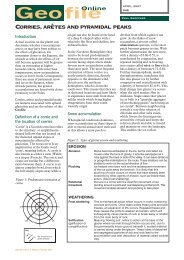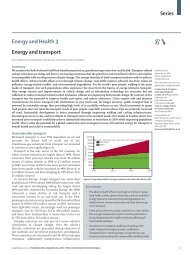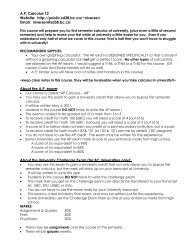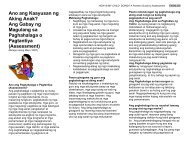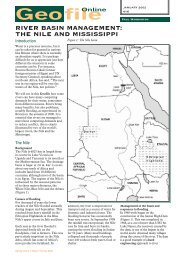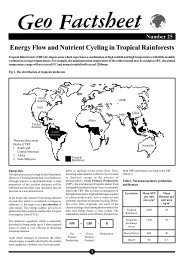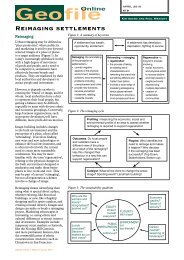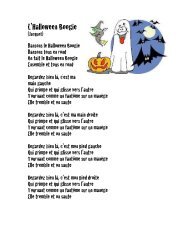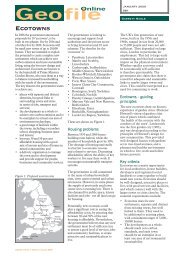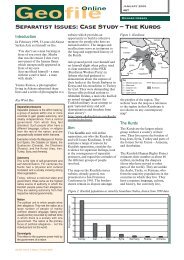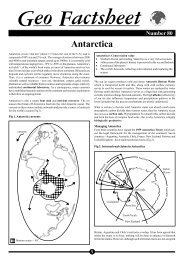<strong>Virgin</strong> – the <strong>new</strong> breed of <strong>MNC</strong>?Geo FactsheetFig 2 <strong>MNC</strong>s: Modes of operationsMODES OF OPERATIONStrategic alliancesafter mergersDirect investmentabroadDynamic networks,entrepreneur ledInternationalsubcontractingInfluences:• market size• political factors• relative exchangerates• governmentincentivesNew buildMarket orientatedinvestment:• manufacturing• property• producer andconsumer servicesAcquisition andmergerBased on naturalresourcesSupply orientatedinvestmentProduction costbasedInfluences:• labour costs& availability• avoidingquotas, tariffs• investmentincentivesHost countrymarketRegionalmarketAssembly offinished productComponentmanufacturersLargely forexportLargely forexportLargely for export -limited host country marketReduced demand and increased competition creates unfavourableeconomic conditions. In order to survive and prosper, <strong>MNC</strong>s had tochange. Three main strategies exist, rationalisation, reorganisation anddiversification. Rationalisation refers to slimming down of theworkforce and their replacement by machines. By contrast,reorganisation includes improvements in production, administration andmarketing, such as an increase in subcontracting of production andadministration. Different parts of products are made at different assemblyplants and then shipped to other plants for intermediate or final assembly– i.e. regionalisation. Increasingly <strong>MNC</strong>s diversified and developed<strong>new</strong> products, notably financial services. This broader base makes themless vulnerable to economic collapse. The name conglomerate is usuallygiven to these very diverse <strong>MNC</strong>s. Sometimes the diversity is too greatand retrenchment back to the main business is necessary.<strong>MNC</strong>s are now:• greatly slimmed down, employing more people indirectly throughsubcontracting• integrating production, administration and marketing on a global scale• increasingly financially orientated – reflecting the globalisation ofservicesInternal changes may result from the entrepreneurial designs of the ownerand board of directors, who see opportunities for <strong>new</strong> investment ininnovative technology or the opportunity to acquire other companies atcompetitive prices.<strong>Virgin</strong> – a case study of economic diversificationWhy <strong>Virgin</strong>?<strong>Virgin</strong> was a name that proclaimed their commercial innocence butalso had a certain shock value, in keeping with the establishmentmood of the times, when <strong>Virgin</strong> was established (1970).<strong>Virgin</strong> is not a classic TNC but is more characteristic of the <strong>new</strong> generation.Globally it employs fewer than 20,000 people, with some indirectlyemployed via subcontracting. It is a company which is largely serviceorientated with very little manufacturing and does have strong interests infinance and e-commerce. All the diverse operations can be linked to the<strong>Virgin</strong> brand name. Research, in 1995, on the <strong>Virgin</strong> brand name showed thatthe brand was recognised by 96% of UK consumers and that RichardBranson was correctly identified by 95% as the company’s founder. Its imagewas perceived by the public as fun, innovatory, successful and trustworthy.This has clearly influenced the way that the company has developed.The actual groupings in the extremely diverse company reflect thepersonal interests and business philosophy of its owner – RichardBranson – essentially to look to the future to solve difficulties through<strong>new</strong> opportunities, expansion and growth. The groups reflect his interestin transport, travel, music, leisure and computing.For instance, <strong>Virgin</strong> moved into leisure (night clubs and airlines) in theearly 1980s following the collapse of the music business worldwide as aresult of recession and high inflation.Many of the business ventures are both high risk and very capital intensive (aparticular issue with the airline and train group). In 1990 <strong>Virgin</strong> Music wassold to raise money for airline expansion. Many ventures, for example inhotels, are joint ventures with companies and partners (especially in Japan).Whilst Fig. 3 emphasises the diversity of <strong>Virgin</strong> operations it is possibleto see a rationale with links between media and publishing, leisure andtransport, and financial services and e-commerce.Many of the latest ventures rely on franchising the marketing power ofthe <strong>Virgin</strong> name, for example in Vodka, Cola, Cosmetics and Wine, oftenusing e-commerce as a means of marketing.<strong>Virgin</strong> makes an excellent case study of a British based conglomerate thatoperates transnationally. On page 3, Table 1 shows a timeline of thedevelopment of the company and Fig. 3 shows the current range of thecompany’s operations and groups.2The general strategy is for Richard Branson and a team of advisors toresearch and develop <strong>new</strong> business, then to hand it over to an outstandingfinancial controller and managing director, who are expected to make thecompany succeed. So <strong>Virgin</strong> consists of numerous small companies,scattered quite widely around the world, operated quasi-independently.This is, again, different from the integrated style of traditional <strong>MNC</strong>s.
<strong>Virgin</strong> – the <strong>new</strong> breed of <strong>MNC</strong>?Geo FactsheetTable 1. The <strong>Virgin</strong> timeline.1968 • First issue of Student magazine published.1970 - 71 • <strong>Virgin</strong> mail-order operation started• First <strong>Virgin</strong> shop opened in Oxford Street1973 • First <strong>Virgin</strong> recording studio opened at The Manor near Oxford• Tubular Bells, by Mike Oldfield, released.1977 • The Sex Pistols signed by <strong>Virgin</strong>1978 - 80 • First <strong>Virgin</strong> nightclub (The Venue)1981 - 82 • Phil Collins, Boy George and Culture Club signed to <strong>Virgin</strong>1983 - 84 • <strong>Virgin</strong> Vision formed: film and video distribution, TV broadcasting• <strong>Virgin</strong> Games launched;• <strong>Virgin</strong> Atlantic Airways and <strong>Virgin</strong> Cargo launched;• First luxury hotel launched (in Mallorca);• The Music Channel, a 24 hour satellite-delivered musicstation, launched by <strong>Virgin</strong> Vision.1985 - 86 • <strong>Virgin</strong> Holidays formed• £25 million raised via convertible stock• <strong>Virgin</strong> Group floated on London Stock Exchange1987 • <strong>Virgin</strong> Records America launched• Japanese subsidiary established• Rushes Video, London, acquired• 525 <strong>Virgin</strong> Communications - LA-based post-productionfacility, launched• <strong>Virgin</strong> Balloon company launched1988 • Olympic Recording Studios opened in London• <strong>Virgin</strong> Classics established to specialise in high-qualityclassical music repertoire• First <strong>Virgin</strong> Megastores opened in Australia, Glasgow and Paris• Smaller UK retail outlets sold to W.H.Smith for £23 million• <strong>Virgin</strong> Broadcasting formed to further develop <strong>Virgin</strong>’sinterests in radio and TV1989 • 10% of <strong>Virgin</strong> Travel sold to Seibu Saison, Japan• 25% of <strong>Virgin</strong> Music sold to Fujisankei, Japan1990 • <strong>Virgin</strong> Music Group launched second US record companybased in New York• Megastores opened in Marseilles, Bordeaux and Belfast• West One Television, a UK post-production company, createdby <strong>Virgin</strong> Communications• Joint venture signed with Marui retail group to operateMegastores in Japan1991 • <strong>Virgin</strong> Book Publishing formed in joint venture withW.H.Smith and Allison and Busby1992 • <strong>Virgin</strong> Music Group sold to Thorn EMI Plc• <strong>Virgin</strong> Games SA established in Paris• UKs first national radio rock station launched in jointventure with TV-AM Plc1994 • <strong>Virgin</strong> Games renamed <strong>Virgin</strong> Interactive Entertainment (VIE)• <strong>Virgin</strong> City Jet service launched in January between Dublinand London City Airport• Joint venture formed by <strong>Virgin</strong> Hotels with ShirayamaShokusan to develop London’s City Hall• <strong>Virgin</strong> Trading formed to market FMCG under the <strong>Virgin</strong>brand name, with first venture in partnership with W.Grant &Sons to market <strong>Virgin</strong> Vodka• <strong>Virgin</strong> Radio awarded FM license in London• <strong>Virgin</strong> Cola Company formed1995 • <strong>Virgin</strong> Direct Financial Services launched• <strong>Virgin</strong> Cola launched1996 • <strong>Virgin</strong> Bride, Europe’s largest bridal-wear shop, opened• <strong>Virgin</strong> Net formed to enter the Internet market• <strong>Virgin</strong> Rail awarded franchise to operate rail passengerservice covering 130 stations in England, Scotland and Wales• <strong>Virgin</strong> Rail awarded Intercity West Coast franchise• Three hotels in Wales acquired by <strong>Virgin</strong> Hotels• 50% share in London Broncos rugby team acquired by Branson• First banking product <strong>Virgin</strong> One Account launched by<strong>Virgin</strong> Direct Financial Services in joint venture with RoyalBank of Scotland• <strong>Virgin</strong> Radio sold for £85 millionFig. 3 The <strong>Virgin</strong> Group of companies: major operations• <strong>Virgin</strong> Travel, especially <strong>Virgin</strong> Atlantic, is the companyclosest to Branson’s heart. With twenty aircraft and routes fromLondon to about a dozen major cities outside Europe, <strong>Virgin</strong>Atlantic remains a niche player in an industry dominated byglobal carriers and state airlines. Since its founding, the airlinehas relied on service, value-for-money, and innovation, dished upwith panache and flair, to differentiate itself in the market. <strong>No</strong>t allthese ideas originated at <strong>Virgin</strong>, but Branson will happily copygood practice if he sees an advantage. Judging by the numerousawards and citations the airline has won, his approach seems towork.• <strong>Virgin</strong> Holidays’ main destination is Florida, where <strong>Virgin</strong> is theDisney Hotels’ biggest customer.• <strong>Virgin</strong> Entertainment owns <strong>Virgin</strong> Cinemas, a cinema chainformed from the purchase of MGM cinemas. <strong>Virgin</strong> sold theninety small sites it acquired, retaining the remainder forconversion to multiplexes.• <strong>Virgin</strong> Retail’s core activity is the chain of fifty-plusMegastores in the UK, in partnership with W.H.Smith.• <strong>Virgin</strong> Express Holdings Plc is a scheduled airline companyserving the main European cities. offering single-class airfaressubstantially below the norm.• <strong>Virgin</strong> Direct and <strong>Virgin</strong> Direct Personal Finance were founded tobring <strong>Virgin</strong> into the personal financial services market.• <strong>Virgin</strong> Direct was initially a joint venture with <strong>No</strong>rwich UnionAssurance, a large insurance group that supplied the technologyand back-office support while <strong>Virgin</strong> supplied the marketing.<strong>No</strong>rwich Union withdrew shortly after the launch in favour ofAustralian Mutual Provident.• <strong>Virgin</strong> Direct Personal Finance links <strong>Virgin</strong> Direct with RoyalBank of Scotland to offer the One account; a combined, highlyflexible mortgage and bank account with a single rate for all lendingpurposes: car loan, house purchase, overdraft, credit card etc.• <strong>Virgin</strong> Rail consists of twenty-year franchises to operate twonetworks: Cross Country, a series of routes that traverse the UK,and West Coast, the main route from London to Glasgow andintermediate stations. The franchises were awarded bycompetitive tendering as part of the long-term denationalisationprogramme of the Conservative government. <strong>Virgin</strong> inheritedrolling stock, ticketing offices and staff, all previously underBritish Rail ownership and management. The tracks, signallingand stations are owned and operated by Railtrack. British Railwas not seen as a customer-friendly and efficient organisation.Furthermore, years of under-investment had had an impact on theinfrastructure. In the short term, however, <strong>Virgin</strong> Rail hadsuffered from poor public relations, with horror stories surfacingfrequently about delayed trains, poor food and dirty trains. <strong>Virgin</strong>Rail management explains that improvements cannot comeovernight.• <strong>Virgin</strong> Rail was initially a joint venture between <strong>Virgin</strong> andventure capitalists. In 1998, Branson made plans to float <strong>Virgin</strong>Rail, intending to offer part of the equity to the public to allow theinitial investors to withdraw.• V2 Music is Branson’s return to the industry that got him started.It was founded as a global business with a presence in manycountries.• <strong>Virgin</strong> Net is an Internet service provider created as a jointventure between <strong>Virgin</strong> and the UK subsidiary of NTL, a UScomputer technology company. <strong>Virgin</strong> is responsible for creativecontent and marketing; NTL provides the backup systems andsoftware.3



